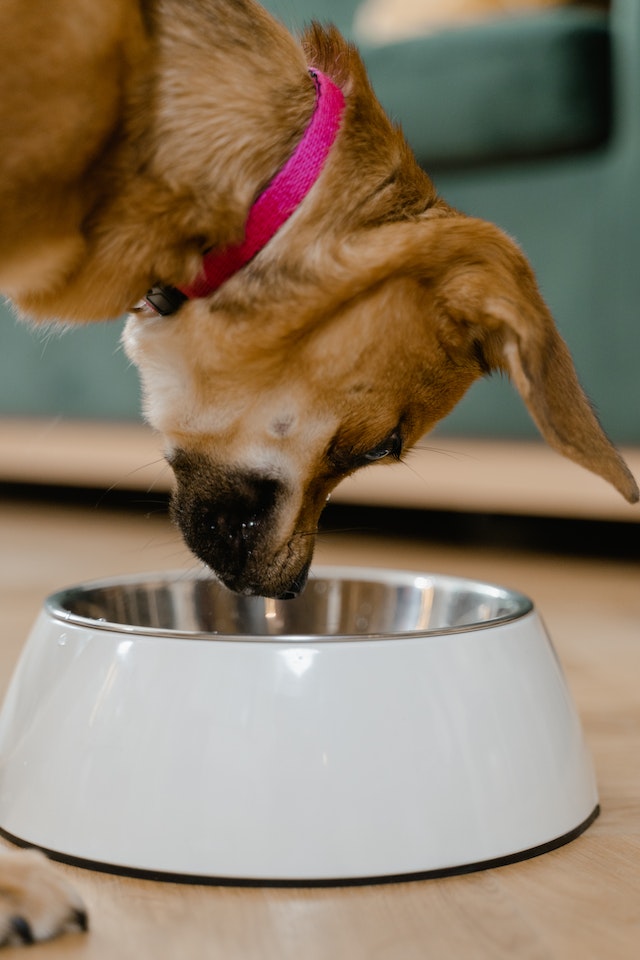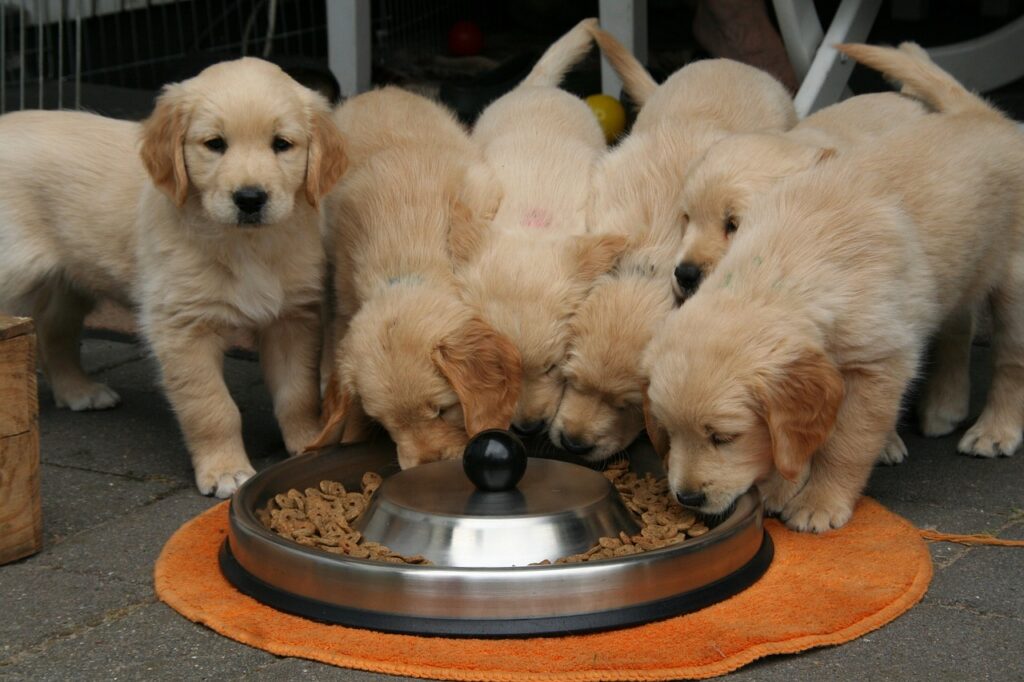A Guide To Choosing
The Right
Dog Food For Your Furry Friend
Knowing your dog’s individual needs, choosing the right food for your dog, and having a clear feeding schedule are major responsibilities of being a dog owner.
Proper nutrition and feeding habits are the most essential aspects of dogs’ health since they play a significant role in their overall health, well-being, and longevity.
Proper nutrition is the foundation of a healthy and happy life for your furry companion.
A proper diet and the right feeding habits offer your dog the
- right nutrients
- good energy and activity levels
- healthy weight
- strong immune system
- healthy skin, teeth, and coat
- digestive health
- overall organ functions,
- helps with development
- prevents malnutrition and deficiencies
This is why choosing the right food for your dog is truly important.

Understanding your dog's nutritional needs
In order to give your dog the right type of nutrition, you must be aware of the nutritional needs dogs have.
Just like humans, dogs’ basic nutritional requirements include proteins, carbohydrates, fats, vitamins, and minerals.
Proteins are the building blocks of the body. They are essential nutrients for muscle development, tissue repair, and enzyme production.
Carbohydrates are the primary source of energy, broken down into glucose, which provides fuel for bodily functions and physical activities.
Fats are an energy source. They are vital for healthy skin and coat.
Vitamins are essential for various bodily functions.
Minerals: Inorganic elements necessary for physiological functions and structures.
So when choosing the right food for your dog it’s good to note that the specific nutritional requirements for dogs can vary depending on different factors. For example age and life stage, size, breed, activity level, and overall health of the dog.
Puppies, for instance, have different dietary needs than adult dogs and large-breed dogs may require more specific requirements for balanced growth.
Also, different types of foods may satisfy different types of needs.
Types of Dog Food
When choosing the right food for your dog, it’s good to know about all of the different options available.
There are 3 main types of dog food: dry, canned, and raw. All of them have their pros and cons, so let’s briefly go through each option:

1. Dry Food:
- Cheapest and easiest to store.
- Provides dental benefits by promoting healthy teeth and gums.
- Energy-dense, but some lack essential nutrients and may contain preservatives.
- Some dry foods have high grain content, which may not be well-digested by dogs.
2. Canned Food:
- Contains more fats and protein, with higher moisture content for easier eating.
- Generally more enjoyable and tastier for picky eaters.
- Some canned foods may include preservatives and have similar nutrient limitations to dry food.
- Can contribute to weight gain and may cause dental problems if it sticks to teeth.
3. Raw Food:
- Most beneficial as it closely resembles a dog’s natural diet.
- Rich in essential nutrients, promoting overall health, energy, and coat condition.
- Some raw foods may require additional fiber from vegetables to enhance nutrient content.
- Homemade raw food can be more expensive and time-consuming.
It can be hard to figure out how to prepare a raw meal for your dog and what meats are the best and safest. Also it may give you a headache when you’re trying to figure out which dry or canned food is the best and safest one. This requires the ability to understand the labels in the dog food.
Reading and understanding dog food labels
With countless options available in the market, understanding the dog food labels becomes crucial in ensuring you make the right choice for your canine friend.
Understanding Dog Food Labels: Dog food labels provide essential information on what ingredients and nutritional value the food has. The primary ingredient listed holds the highest concentration in the food, making it essential to seek high-quality animal-based proteins like chicken, beef, lamb, or fish. To ensure you’re giving the best possible food for your dog’s well-being, choose a dog food that is labeled “complete and balanced”. The label indicates that it meets the nutritional standards set by the Association of American Feed Control Officials (AAFCO) for the specific life stage of your pet.
Ingredients to Look For: To give your dog the better quality nutrition it’s best to choose a food that has concentrated protein sources. These kinds of foods are named with animal ingredients such as “chicken meal” or “salmon meal.” Also, high-quality carbohydrates, such as whole grains (e.g., brown rice, oats) and vegetables (e.g., sweet potatoes, peas), contribute to your dog’s energy levels and overall health.
Ingredients to Avoid: Stay away from dog foods that use unclear terms like “meat by-products” or “animal meal” as these foods may contain unspecified and lower-quality ingredients. Also it’s best to avoid artificial preservatives like BHA, BHT, and ethoxyquin in favor of natural preservatives like tocopherols (vitamin E) and ascorbic acid (vitamin C). Additionally, watch out for excessive fillers, artificial colors, and flavors, which offer little to no nutritional value.
Common Labeling Terms:
Most foods may contain common labeling terms that may be confusing to you, so let’s go over them:
-
Complete and Balanced signifies that the dog food contains all the essential nutrients required for your pet’s specific life stage, as determined by AAFCO standards.
-
Grain-Free dog foods do not include traditional grains like corn, wheat, or soy. While suitable for some dogs with grain sensitivities, it’s essential to ensure these foods still provide adequate nutritional value through alternative ingredients.
-
The term “natural” on dog food labels generally means that the ingredients used have not undergone significant processing or artificial alterations. However, it is essential to look over the ingredient list to verify the actual source of nutrients.
In conclusion, reading and understanding dog food labels is a skill that helps you as a pet owner to make informed decisions about your furry companion’s nutrition. By focusing on high-quality, complete, and balanced foods with natural ingredients that satisfy your dog’s individual needs, you can ensure your dog enjoys a healthy, energetic, and vibrant life.
Special Dietary Considerations
Every dog is unique, and some may require a special diet due to allergies, sensitivities, or underlying health conditions. In these cases, specialized diets can be crucial in supporting their overall health and well-being. Identifying allergens is a crucial in preventing adverse reactions.
By understanding your furry friend’s specific needs, you as a pet owner can provide tailored nutrition that supports optimal health, manages sensitivities, and improves the overall quality of life of your dog. Tailoring your dog’s diet can help with managing possible allergies, digestive issues, weight, joint health, and chronic diseases.
Opt for limited-ingredient diets that contain only a few, easily digestible ingredients. These diets reduce the risk of triggering allergic reactions and aid in pinpointing specific allergens.
Choose proteins that your dog has not been previously exposed to, reducing the likelihood of allergic reactions. For example, some dogs may be allergic to all poultry but can eat lamb and pork.
For dogs with grain sensitivities, grain-free diets can be beneficial. Replacing grains with alternative carbohydrate sources like sweet potatoes or peas can improve digestion and reduce potential allergens.
Try avoiding common allergens for dogs. These include chicken, beef, dairy, and wheat. If your dog has known sensitivities to any of these ingredients, avoid them in their diet.
In addition to tailored nutrition, regular veterinary check-ups and open communication with your veterinarian are essential for monitoring your dog’s health and adjusting their diet as needed.
The vet can also help with making a specified diet for him.
Remember to observe any changes in your dog’s behavior, appetite, or physical condition, as these can indicate potential issues that require attention. Providing a loving and supportive environment, coupled with the right diet, will contribute to a long and fulfilling life for your beloved canine companion.
Establishing healthy feeding habits
Feeding our canine companions is more than just offering a meal; it’s about providing the right nutrition and ensuring their overall health and well-being. Proper portion control and feeding frequency play a vital role in maintaining a healthy weight and supporting their energy levels.

Guidelines for Portion Control and Feeding Frequency:
Age: Puppies require more frequent and smaller meals to support their growth and development.
So puppies under 6 months of age may need to be fed 3-4 times a day.
As they grow older, the feeding frequency can be gradually reduced to 2-3 times a day.
Adult dogs usually need only two meals per day, but this can vary based on individual needs.
Weight: A dog’s weight is a critical factor in determining portion size.
Follow feeding guidelines provided on the dog food packaging, and adjust portions as necessary to maintain a healthy weight.
Overweight dogs may need smaller portions, while underweight dogs might require larger ones.
Activity Level:
Active and highly energetic dogs may need more calories to sustain their lifestyle.
On the other hand, less active or senior dogs may require fewer calories to prevent weight gain.
Maintaining a proper feeding routine is essential for a dog’s overall health
- It helps regulate a dog’s metabolism, ensuring they have a steady supply of energy throughout the day.
- A predictable feeding routine can aid in house-training and prevent accidents in the house.
- It fosters a sense of security and routine for dogs, reducing stress and anxiety.
Tips to prevent overfeeding and obesity:
- Measure portions accurately with a measuring cup.
- Avoid feeding table scraps and high-calorie treats.
- Ensure regular exercise to manage weight and improve overall health.
- Monitor your dog’s weight and adjust portions accordingly.
Picky eaters
Mealtime challenges can be a source of concern for dog owners with picky eaters. A selective appetite in dogs may lead to inadequate nutrition and potential health issues. Encouraging picky eaters to try new foods can be a gradual process that requires patience and persistence.
1. Gradually increase the amount of new foods. Start by mixing a small amount of the new food with your dog’s regular diet. Gradually increase the proportion of the new food over several days or weeks, allowing your dog to become familiar with the taste and texture.
2. Different textures and flavors: Just like humans, dogs can have preferences for certain textures and flavors. Offer your dog different options such as wet and dry foods or various protein sources. Observe how your dog responds in order to determine his preferences and gradually add these to his diet.
3. Positive Reinforcement can be a useful tool to encourage your dog to try new foods. Offer praise, treats, or affection when he willingly eats the new food. Associating positive experiences with mealtime can gradually change your picky eater’s attitude towards unfamiliar foods.
4. Have a proper feeding schedule. By sticking to a regular feeding schedule you can establish a routine for your dog. Set specific mealtimes and avoid leaving food in the bowl out all day. A structured routine can encourage your dog to eat during designated meal times.
5. Limit treats. Reduce the number of treats you offer to your dog so it decreases the amount your picky eater eats throughout the day. Therefore he can be more willing to eat his own food because excessive snacking can decrease his appetite during main meals. Reserve treats for training sessions and as rewards for trying new foods.
6. Consult your veterinarian: If your picky eater’s behavior continues or worsens, it’s important to contact your veterinarian. Sometimes picky eating can sometimes be a sign of an underlying health issue. Your vet can exclude any medical conditions and offer guidance tailored to your dog’s specific needs.
Encouraging a picky eater to try new foods is a gradual process that requires patience. With time and persistence, your picky eater may start to become candid and, enjoy a nutritious diet, supporting his overall health and well-being.
Treats and snacks
Treats and snacks can be an enjoyable and effective way to reward and bond with your furry friend.
However, their role in a dog’s diet should be approached with careful consideration to ensure your dog is overall healthy.
Treats give your dog positive reinforcement during training, offering encouragement and strengthening the bond between you and your dog. Therefore treats can reinforce good behavior and provide mental stimulation.
However, giving excessive amounts of treats to your dog can lead to weight gain, dental problems, and an unbalanced diet. Treats should only be a bonus in your dog’s diet, so striking a balance is crucial to the dog’s overall nutrition.
So when choosing what treats to give to your dog, it’s good to choose healthy treats that your dog loves. So how to choose them?
Healthy and appropriate treat options:
Training Treats: Choose small, low-calorie treats specifically designed for training purposes. These treats allow for frequent rewarding during training sessions without having a major increase in daily caloric intake.
Fruit and Vegetables: Certain fruits and vegetables, such as apple slices and carrots, can be healthy and natural treats for your dog. Ensure that the chosen options are safe and non-toxic for dogs.
Commercial Dog Treats: Opt for high-quality, all-natural dog treats made with wholesome ingredients. Check that the treats come with no artificial preservatives, colors, or flavors.
Frozen Treats: In hot weather, consider frozen treats like frozen fruit or yogurt cubes as a refreshing option.
Homemade Treats: By preparing your dog’s treats at home it gives you control over the ingredients. It allows you to pick the components of your dog’s specific dietary needs and preferences. Research and use dog-safe recipes.
Remember to emphasize moderation and avoid harmful foods:
When offering treats to your dog, moderation is the key. As a general rule, treats shouldn’t make up any more than 10% of a dog’s daily caloric intake. Be mindful of portion sizes and the number of treats given daily.
Additionally, it is crucial to avoid feeding dogs harmful or toxic foods, such as chocolate, grapes and raisins, onions and garlic, avocado, xylitol, alcohol, and bones from cooked meat.
If you want to learn more about foods you shouldn’t feed your dog
Also, always consult your veterinarian if unsure about the safety of specific foods for your dog.

Other important factors
1. Proper Water Intake: Water is a fundamental element of a dog’s well-being. Hydration is vital to maintain your dog’s bodily functions, regulate body temperature, and support overall health. Dogs should always have fresh and clean drinking water available to them. Proper water intake prevents dehydration and helps with preventing health issues, such as urinary problems and heat-related illnesses, especially during warm weather or after physical activity.
Benefits of Regular Veterinary Check-Ups: Regular veterinary check-ups are essential in maintaining a dog’s health and detecting potential health problems early. Routine inspection allows veterinarians to assess a dog’s overall well-being, address concerns, and provide preventative care, such as vaccinations and parasite control. These check-ups also enable the vet to tailor specific health recommendations based on each dog’s age, breed, and lifestyle. Early detection of health issues can lead to timely intervention and effective treatment, increasing the chances of a positive outcome and a longer, healthier life for our canine companions.
In conclusion
Choosing the right dog food for your furry friend is a critical responsibility that directly impacts their health and well-being. Throughout this comprehensive guide, we have explored various aspects related to dog food and feeding practices to help you make informed decisions.
- Understanding your dog’s nutritional needs includes knowledge about the essential nutrients dogs require, tailoring their diet based on life stages, breeds, and sizes.
- Different types of dog food available, from dry kibble to wet canned food and raw diets
- The importance of reading and understanding dog food labels.
- The benefits of specialized diets for dogs with allergies, sensitivities, or health conditions
- Portion control and feeding schedule based on age, weight, and activity level.
- Picky eaters and introduced strategies to encourage them to try new foods
- The role of treats and snacks in a dog’s diet.
- Importance of proper water intake
- Benefits of regular veterinary check-ups.
By combining all these factors, you can make well-informed decisions regarding your dog’s nutrition, tailoring their diet to meet their specific needs and preferences. With this guide, you can confidently provide the best possible care for your furry friend, nurturing a strong and loving bond that will endure for years to come.